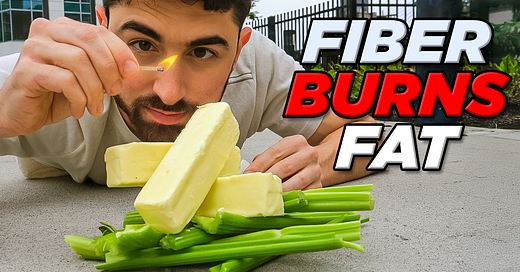The Fiber that Burns Fat & Mimics Keto
New research shows that this specific fiber burns fat, mimics a ketogenic diet, and can contribute to weight loss. This is not your run-of-the-mill granola or chia seed...
New research shows that this specific fiber burns fat, mimics a ketogenic diet, and can contribute to weight loss. This is not your run-of-the-mill granola or chia seed. And if you’re here expecting a gimmicky shopping list of fat-burning foods, you’re going to be disappointed. But if you’re receptive to having your expectations broken and mind awoken, then let’s digest this together.
The fat–fiber–feces story I’m going to tell you is based on a new August 5, 2025 study published in Cell Metabolism, where mice were given a fiber complex called acetylated-cellulose (AceCel).
What is Acetylated-Cellulose (AceCel)?
AceCel is the short-chain fatty acid (SCFA) “acetate” bound to the fiber cellulose.
Perhaps you’ve heard of SCFAs? These are little fats, between 2–4 carbons long, and Acetate (2 carbons), propionate (3), and butyrate (4). Basically, the short kings of the fat world. In randomized, double-blind controlled human studies, acetate administration to the colon has been shown to improve metabolic parameters.
But there’s a catch!
If you just eat acetate, it won’t make it all the way to the colon. In the human studies, acetate is delivered through a long feeding tube. Not fun.
Therefore, as much as you want to deliver acetate to the colon by simply eating it, you can’t.
Trying to get acetate to your colon is like bowling on a slanted alley—every roll’s a gutter ball. But AceCel walks up with a baseball bat and clears the pins… WHACK! Strike!
AceCel Causes Weight Loss in Mice
In the study, AceCel allowed acetate to escape absorption in the small and increased acetate levels in the colon, whereas a control acetate sodium (AceNa) solution did not.
Impressively, AceCel fiber (green) caused significant weight loss relative to mice given a control diet with or without the alternative AceNa form of acetate (orange and grey). AceCel also decreased liver mass and led to a trend in decreasing body fat.
These findings were replicated in another group of genetically distinct (Ob/Ob) obese mice, and the findings were specific to AceCel and did not occur when mice were given a cellulose complex with the other SCFAs (propionate and butyrate).
To summarize, AceCel delivers acetate to the colon, which suppresses weight gain.
Mechanism: How AceCel Fiber Mimics Fasting & Keto
The next question: How does AceCel contribute to weight loss?
*Nuance Note (skippable): Before I tell you the answer straight-up, I want to confide in you that I struggled with whether I wanted to reveal the answer in a direct fashion. What I mean by this is that, if I just give you the answer, it deprives you of walking through the sequence of questions the researchers asked to reveal the mechanism. I want to show you how scientists work through these metabolic quandaries, rather than just present the completed puzzle. But then it occurred to me: if I present to you the mechanism in a forward step-by-step fashion, you can—if you so choose—contrast my story from the order in which the data are presented in the paper. Therefore, for those of you who want the direct digest because your trust me, you’ll have it! And, thinking hopefully, it will create extra incentive for some of you to grapple with the paper. Was this reflection helpful, or is this useless jabbering?
The mechanism they discovered operates as follows:
AceCel delivers acetate to the colon.
Acetate alters the microbiome to increase levels of Bacteroides species that ferment and metabolize simple sugars.
This decreases availability of sugars to the host (mouse or you).
Liver glycogen is depleted, partially mimicking fasting or a ketogenic diet.
As a compensatory response, genes involved in fat burning (fatty acid oxidation) are increased.
The net effect is improvements in fatty liver, fat burning, and weight loss.
With that said, I still want to show you some graphs to hammer home the point, and make some further connections.
In the rest of this letter, we will discuss:
Data on the Effects of AceCel on Fat Burning (Fatty Acid Oxidation)
Benefits of Bacteroides & the Bio-individual Response
Relationship to the hormone, FGF-21 (Callback to the Sugar Diet)
Acetogenic Fibers (Inulin)
Acetate producing bacteria
Acetic Acid and Apple Cider Vinegar
Keep reading with a 7-day free trial
Subscribe to Nicholas’s Substack to keep reading this post and get 7 days of free access to the full post archives.






